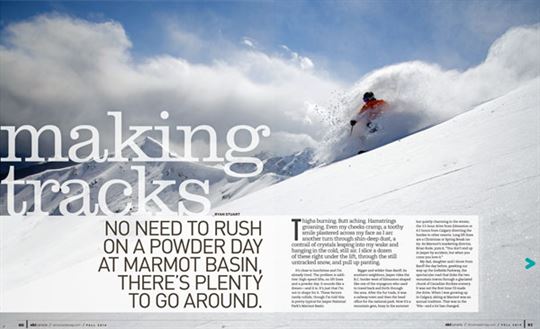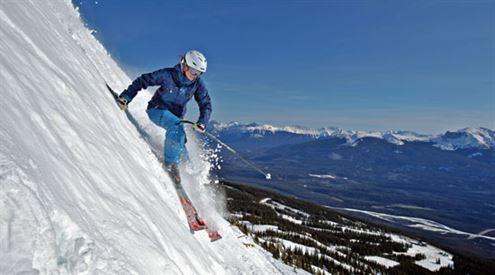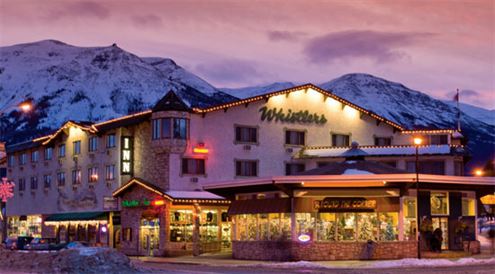No need to rush on a powder day at Marmot Basin, there’s plenty to go around.
Thighs burning. Butt aching. Hamstrings groaning. Even my cheeks cramp, a toothy smile plastered across my face as I arc another turn through shin-deep dust, a contrail of crystals leaping into my wake and hanging in the cold, still air. I slice a dozen of these right under the lift, through the still untracked snow, and pull up panting.
by Ryan Stuart in the Fall 2014 issue
It’s close to lunchtime and I’m already tired. The problem is additive: high-speed lifts, no lift lines and a powder day. It sounds like a dream—and it is. It’s just that I’m not in shape for it. These factors rarely collide, though I’m told this is pretty typical for Jasper National Park’s Marmot Basin.
Bigger and wilder than Banff, its southern neighbour, Jasper rides the B.C. border west of Edmonton shaped like one of the voyageurs who used to travel back and forth through the area. After the fur trade, it was a railway town and then the head office for the national park. Now it’s a mountain gem, busy in the summer but quietly charming in the winter, the 3.5-hour drive from Edmonton or 4.5 hours from Calgary diverting the hordes to other resorts. Long lift lines are a Christmas or Spring Break rarity. As Marmot’s marketing director, Brian Rode, puts it, “You don’t end up in Jasper by accident, but when you come you love it.”
My dad, daughter and I drove from Banff the day before, gawking our way up the Icefields Parkway, the spectacular road that links the two mountain towns through a glaciated chunk of Canadian Rockies scenery. It was not the first time I’d made the drive. When I was growing up in Calgary, skiing at Marmot was an annual tradition. That was in the ’90s—and a lot has changed.
Back in the powder, between gasps for air, I pull out a stall tactic and ask my guide about the lack of lift lines; we’re skiing right onto every lift.
“This is a pretty typical crowd for a mid-week powder day,” says George Andrew, a Marmot Basin ski instructor and hotel owner in nearby Jasper. “It’s why I like living here.”
He and his wife, Yanka, have been leading my dad and me around the resort all morning, while my daughter Paige takes a lesson. We couldn’t ask for a better guide. Andrew grew up in Jasper and has been skiing at Marmot Basin since he was 12, from the resort’s opening day 50 years ago. He remains a powder-day regular and knows all the intricacies of the ski area.
We started the day on the longest lift in the Rockies, the Canadian Rockies Express. It rips up two-thirds of the mountain fast enough to create a wind chill. I hunker into my jacket, closing the gap between my goggles and coat as I remember the two slow lift rides it used to take to reach the same point. I don’t have long to reminisce as we come flying into the unload.
Two sweet powder runs later we arrive back at the top of the Rockies Express. The lift sits on one side of the giant bowl that is Marmot; we can see most of the resort from here, including the Knob Chair, the highest lift accessing a bunch of wide, open terrain. It had been closed for avalanche control, but now we can see riders filling its chairs. We beeline to it, traversing across the titanic wall of white and then carving a few high-speed turns into the load.
The Knob was my stomping ground as a teen. As the old double bounces toward a lofty ridge, I spot the jumps and cliffs we used to huck ourselves off. A surge of adrenaline pumps through me just as the first skiers rip beneath me and hit some of those same lines, creating mini-explosions as they touch down.
At the top Andrew leads us onto another vast slope, basking in the sun. We charge down it, whooping through the soft and light powder, naturally regrouping as the terrain benches and drops again. We’re soon back on the Knob Chair heading for another lap, no lift line slowing us down.
The Knob is one of the only lifts that hasn’t been upgraded since 2003, when a group of Edmonton and Jasper entrepreneurs bought the hill with the intention of modernizing it. In the decade since they spent $30 million upgrading and expanding everything from lifts to the day lodge. With no on-slope accommodation, every cent went to the skier experience.
It’s an impressive accomplishment, especially given its location. Inside national parks, resorts wage very public wars with Parks Canada to paint a lift tower or renovate a lodge, so expanding the lift system is truly daunting.
I quiz Andrew about this dichotomy. “They know when to shut up,” he says, before adding that the relationship has always been co-operative and friendly between the ski hill and the park bureaucracy. “The hill realizes this is a special place. They know they’re going to have to make compromises and they’re prepared to do that.”
I, too, am ready for compromise: lunch rather than more turns. But first we ride the Eagle Ridge Quad. From the top, the terrain pitches off both sides of a ridge, back into the main basin or down to the bottom of the resort. We choose the basin, but after each pitch we cut hard right, milking the off-fall line glades for all their worth. In the trees the snow has piled into drifts that explode into faceshots when we hit them. It’s a blast and only gets better when we pop out near the top of the Eagle Express Quad and drop onto a major run still covered in untouched snow. I’m shocked, but don’t question our good fortune as we carve big turns all the way to the bottom of the hill.
We ski right to the day lodge, which feels equal parts efficient and welcoming, and meet up with Paige, who—we learn beat us to the opening at Knob Chair.
In the afternoon, with the instructors ditched and skiing on our own, three generations of Stuarts set out exploring. Paige leads the way into glades, where freshies have piled into moguls. We rip down open runs, playing in the softpacked, fool around on gentle cruisers and venture back up the Knob to the steeps of Charlie’s Bowl. We bounce from lift to lift, rarely wasting a run to reposition.
“It’s one of the nice things about Marmot,” says Rode, the hill’s marketing guy. “You can see all the lifts from any other lift. You look over and say, ‘I want to ski there,’ and the next run you’re riding that lift.”
It makes Marmot a great family hill. By late afternoon my dad and I want to get in one more run, while Paige is ready for a cruise to the bottom. We split up and I don’t worry she’ll get lost. She can’t; all runs lead to the base.
That family-friendly vibe extends off the mountain, too. The day before we went for a snowshoe tromp with Paula Beauchamp from Walks and Talks Jasper. A former park interpreter and Jasper local, she supplied snowshoes and drove us to a trail, where we wandered through the snow following animal tracks, while Beauchamp filled us in on the ecology and geography of the area. Paige led the way, running ahead and flopping in the snow for fun.
Then the morning after the powder day dawns clear and cold. Rather than freeze our butts on the lifts, we decide to take a guided tour of Maligne Canyon instead, figuring a hike will keep us warm.
A quick stop at the Maligne Adventures tour office in downtown Jasper has us equipped and on our way to the trailhead just out of town. Along the way we count a dozen elk grazing beside the highway. The resident ungulates are a constant presence around town and a big hit with Paige.
Out of the car the cold air cuts through my outer layers and prickles my skin. Frosty breaths hang in the air. John, our guide, leads the way, crunching through the snow.
“I know a lot and I’m very good at making up what I don’t know,” he says, setting the tone.
On the surface the tour is a beautiful guided hike on the river ice through a canyon full of frozen waterfalls, but there’s far more going on. Maligne roughly translates to evil in French and it gets that name for its mysterious ways. While other rivers are solid ice, the Maligne flows. Springs bubble up here and there. Water disappears and reappears and seems to flow upstream and down.
John’s a master with kids, engaging Paige in sleuthing the mystery of the Maligne, while filling in all the scientific details and fun anecdotes about its geology to the adults. There’s even a tie-in with Marilyn Monroe’s death. While filming part of River of No Return along the Maligne River, she slipped and hurt her ankle. She started taking painkillers, which may have led to her addiction and eventual death. “That’s how evil this place is,” says John.
Back in Jasper, our fingers thawing out, we zip back up to Marmot for an afternoon of skiing. As we drive from the valley to the base, at 1,700 metres it’s the highest in Canada, the thermometer climbs, too.
“It’s pretty common for it to be 10 degrees colder in town,” explains Rode. “Or cloudy in the valley and sunny up here.”
We don’t get the sun but are happy for the warmer temperatures. We spend the afternoon exploring more of the resort. It doesn’t take us long to figure out the general layout, but on every run we find another little stash or secret spot we missed before. And we fall for the whole mellow, friendly and quiet vibe.
Everyone we meet seems to know everyone else we meet. All have long histories in Jasper, a big difference from the usual transient nature of mountain towns. They all love Marmot and Jasper. They know it’s not the biggest or the baddest or even the best. It’s more of an accumulation of good that makes it great.
“There’s nowhere like Jasper,” says Rode. “Banff is the closest, but it has a more urban vibe. We’re lower key, easier going, quieter, quainter and less touristy.”
I don’t know about all that, but I do know that on my last run of the day, two days after a storm, still no lift line in sight, I turn onto Slash, a main run on the lower mountain, and find a field of barely tracked powder. Now that’s worth sore muscles and a long drive.
skimarmot.com






